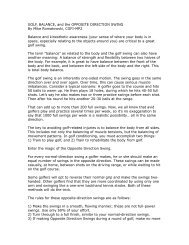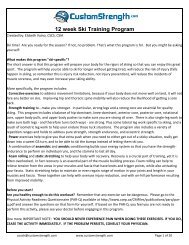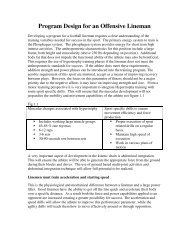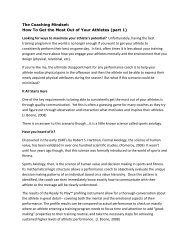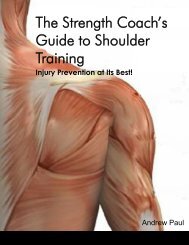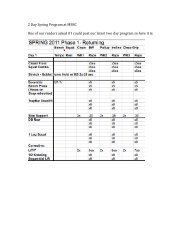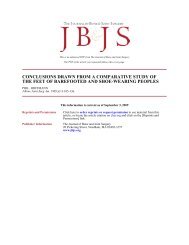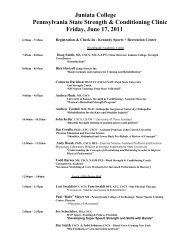Sprint Interval Training - “It's a HIIT - Strength Coach.com
Sprint Interval Training - “It's a HIIT - Strength Coach.com
Sprint Interval Training - “It's a HIIT - Strength Coach.com
Create successful ePaper yourself
Turn your PDF publications into a flip-book with our unique Google optimized e-Paper software.
factors for individuals with heart failure. Of particular interest were increases in the LV ejection fraction (35%) and<br />
stroke volume (17%). Interestingly, it was also shown that AIT, but not MCT, reduced the plasma levels of oxidized<br />
LDL by 9% and increased the patients’ antioxidant status by 15%. This latter increase correlated with the greater<br />
increase observed, by the AIT group, in flow mediated arterial dilation. Further, the patients’ quality of life,<br />
established via a questionnaire, increased more with AIT than MCT. It is also interesting to note that informal<br />
<strong>com</strong>ments from the patients found the varied procedure of AIT motivating, whereas, MCT was described as “quite<br />
boring.” So, at the end of the day, in patients with post‐infarction heart failure, AIT was superior to MCT in<br />
improving LV remodeling, aerobic and anaerobic capacity, arterial function, and quality of life. But I guarantee, a<br />
nationwide survey of health care professionals at this point in time, would yield the opposite prediction which,<br />
emphasizes again, the importance of research awareness. Now, the alert reader will have recognized a difference<br />
in the interval training employed by the Wisløff research team <strong>com</strong>pared to much of the research referenced in<br />
this manuscript, it was <strong>HIIT</strong> but not SIT. The 4‐minute work intervals employed by the Wisløff protocol are longer<br />
than the suggested 60‐second maximum I have promoted throughout this discussion. As I described earlier, when<br />
one is exercising at an intensity that allows for a 4‐minute effort, it is not an “all‐out” effort; so one may think that<br />
a true “all‐out” effort, lasting from 20‐60 seconds, would create a much greater stress on the heart and, in turn, be<br />
less safe. However, by now, you will hopefully have grasped the fact that giving an “all‐out” burst of effort has a<br />
similar stress to the heart, and cardiovascular system, to a “maximal” aerobic effort; the remainder of the energy<br />
required to go “all‐out” <strong>com</strong>es from one’s anaerobic system. The interval training utilized by the Wisløff group<br />
elicited a 95% peak heart rate; one does not get to their maximum heart rate in 20‐60 seconds. Consequently, it is<br />
my contention that <strong>HIIT</strong>, utilizing intervals of 20‐60 seconds, would produce results to an equal or even greater<br />
extent than found by Wisløff et al. An interesting case‐study from a colleague, Robert Mottram, PT., who<br />
employed a 12‐minute per week SIT protocol with his clients, lends support to my contention; as well as, of course,<br />
all the research already discussed in individuals without heart failure. A patient that had been cleared to exercise<br />
by his physician, following multiple bypass surgery, undertook the 12‐minute per week SIT protocol (using a<br />
portable stepping device called The X‐iser® Machine that will be discussed later in more detail) and returned to his<br />
cardiovascular specialist for a follow‐up after about eight weeks of training. After numerous tests, he was given a<br />
15



